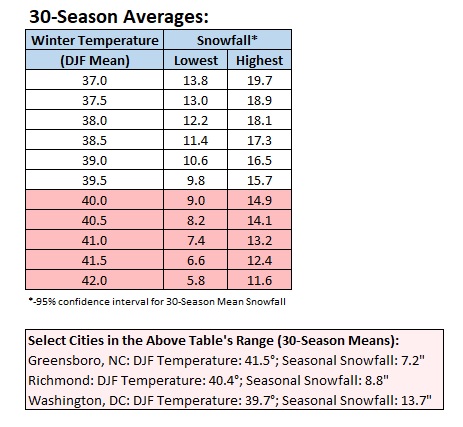PRINT AS PDF
Winter 2022-2023 has been exceptionally warm and remarkably snow-free in the northern Middle Atlantic region. Through February 12th, New York City has seen its lowest seasonal snowfall on record with just 0.4” of snow. Winter 2019-2020 finished with just 4.8” for the entire snow season (July 1-June 30).
With climate change continuing to produce warming, what might seasonal snowfall look like in the warmer winters to come, especially a decade or two in the future?
The winters in the lower Middle Atlantic region provide some insight. Based on a regression equation that included Norfolk, Raleigh, Richmond, and Washington, DC (coefficient of determination: 0.836), it is likely that winters will become much less snowy, on average. The current seasonal average for New York City is 29.8”. With season-to-season variability, there will still be some snowy winters, but those winters will become less frequent.
Finally, to see how things might be playing out relative to the expectations from the regression equation, I examined winters with mean temperatures of 37.0° or above and 40.0° or above in New York City and Philadelphia. Those are individual winters and are not equivalent to 30-season averages. They also fall into colder regimes, which could skew seasonal snowfall higher. Sample size issues, especially with the warmest (40.0° or warmer) winters arise e.g., Winter 2015-2016, which saw a historic snowstorm, skews the mean figure for the small sample sizes.
For Winters with a Mean Temperature of 37.0° or Above:
New York City: Mean Temperature: 38.4°; Mean Snowfall: 18.1″
Philadelphia: Mean Temperature: 38.9°; Mean Snowfall: 13.0″
For Winters with a Mean Temperature of 40.0° or Above:
New York City: Mean Temperature: 40.8°; Mean Snowfall: 12.3″
Philadelphia: Mean Temperature: 41.2°; Mean Snowfall: 11.1″




